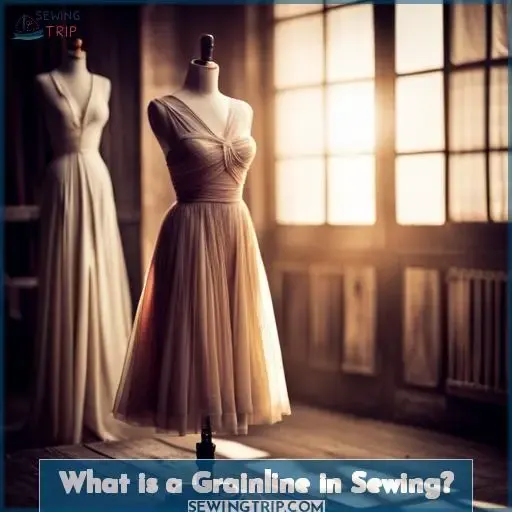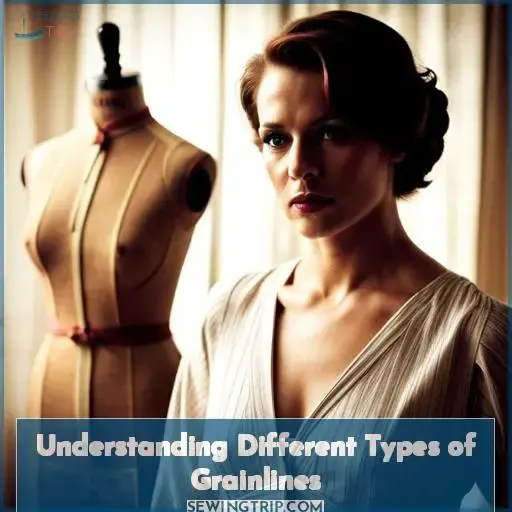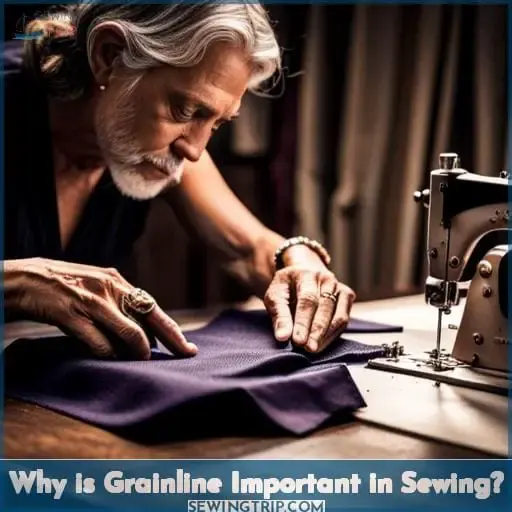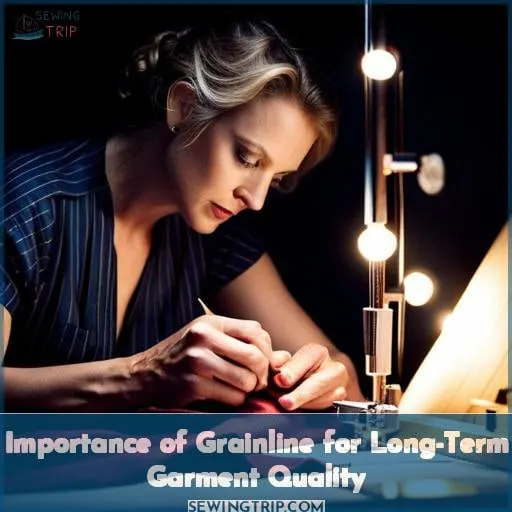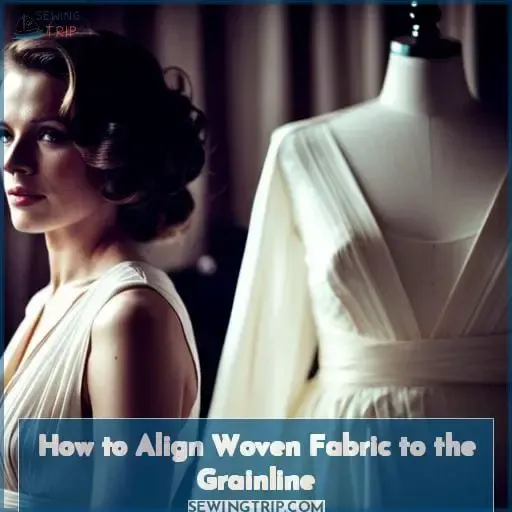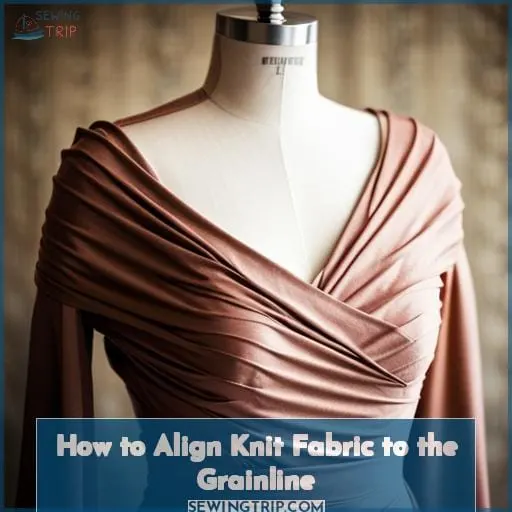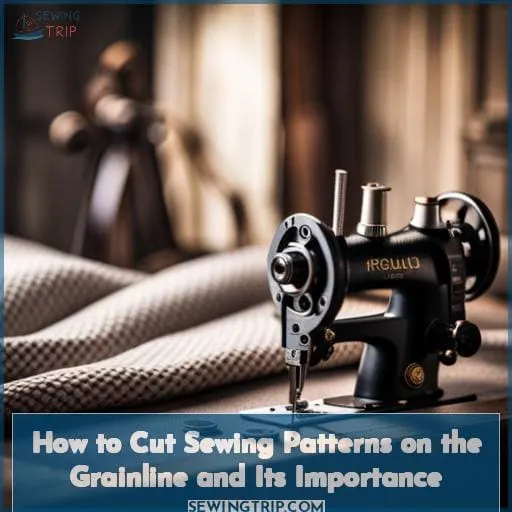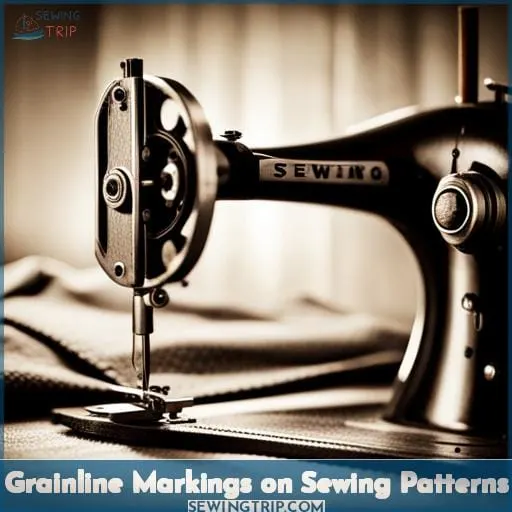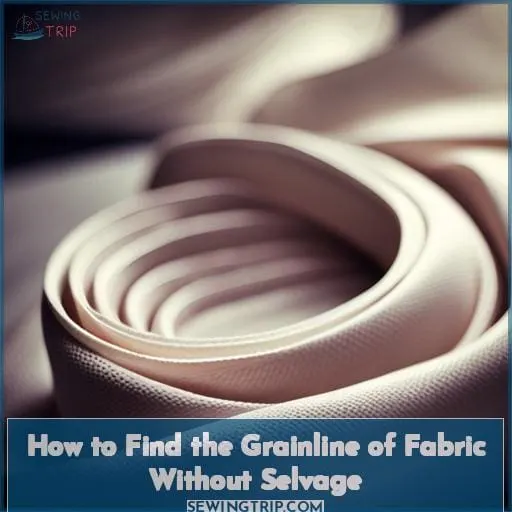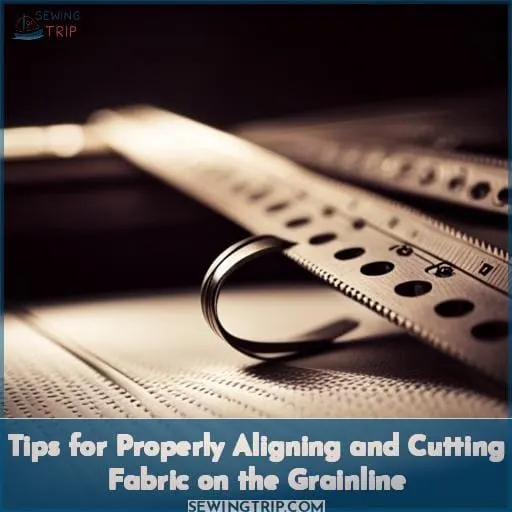This site is supported by our readers. We may earn a commission, at no cost to you, if you purchase through links.
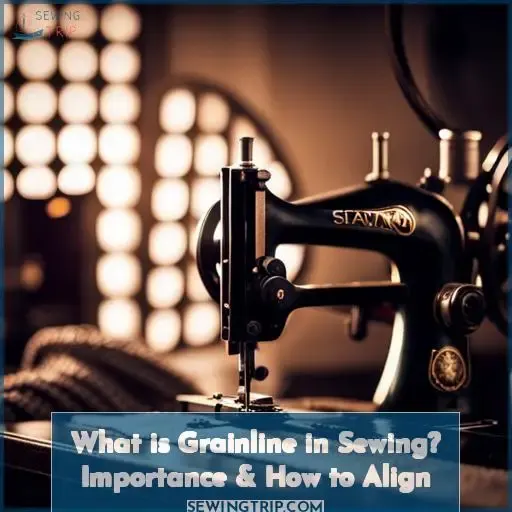 Grainline refers to the lengthwise yarns of a fabric weave which run parallel to its selvedge. These are usually marked with arrows on a sewing pattern. Properly aligning fabric to this line ensures your garments will retain their shape over time and be comfortable when worn.
Grainline refers to the lengthwise yarns of a fabric weave which run parallel to its selvedge. These are usually marked with arrows on a sewing pattern. Properly aligning fabric to this line ensures your garments will retain their shape over time and be comfortable when worn.
So understanding grainline is worth learning for any fashion designer, seamstress or sewer.
In this article, we’ll discuss what grainline in sewing is, why it matters and how you can align fabrics correctly along grainlines without selvage edges as reference points.
Grainline refers to the lengthwise yarns in a fabric that run parallel to the selvedge edges. These are usually marked on a sewing pattern with arrows showing the direction of the grain. Aligning the grainline properly when cutting out pattern pieces helps ensure the finished garment will drape nicely and retain its shape after laundering.
Understanding grainline is key for constructing well-fitting, durable garments. It provides stability and prevents stretching out of shape. Even without selvedges to use as a guide, you can identify the grain by gently pulling along the fabric’s length until it feels less flexible.
The stiffer direction indicates the grainline. Mark this with chalk before laying out your pattern.
With some knowledge of how grainlines work, you can gain mastery in garment construction. Your clothes will fit and function as intended. Take time to align fabric properly before cutting.
Table Of Contents
- Key Takeaways
- What is a Grainline in Sewing?
- Understanding Different Types of Grainlines
- Why is Grainline Important in Sewing?
- Importance of Grainline for Long-Term Garment Quality
- How to Align Woven Fabric to the Grainline
- How to Align Knit Fabric to the Grainline
- How to Cut Sewing Patterns on the Grainline and Its Importance
- Grainline Markings on Sewing Patterns
- How to Find the Grainline of Fabric Without Selvage
- Tips for Properly Aligning and Cutting Fabric on the Grainline
- Conclusion
Key Takeaways
- Grainline in sewing refers to the lengthwise yarns that run parallel to the selvedge.
- Properly aligning the grainline is crucial for achieving good fit and drape.
- With knits, it’s important to consider the stretch direction when aligning the grainline.
- Precise cutting along the grainline helps ensure proper fit and drape in the finished garment.
What is a Grainline in Sewing?
When working with fabric, aligning the grainline is crucial for achieving proper drape and fit. To find the grainline, use selvages or pull threads; then, carefully cut and match pattern markings, considering how different grainlines interact.
Function of a Grainline
You’ll align the fabric’s grain with the pattern’s grainlines so your finished garment has the proper shape and drape. Correct grainline alignment ensures the garment hangs smoothly without twisting or distorting.
Matching the fabric’s straight grain to the pattern’s straight grainlines provides stability and structure. Angling the fabric along the bias grainline creates flexibility for body-hugging designs.
Importance of Grainline
Grasping grainline guides garments to gracefully glide onto your gorgeous figure. Following grainline markings is crucial when cutting out pattern pieces to achieve proper garment fit and drape.
- Aligns fabric warp and weft threads.
- Maximizes stability and stretch.
- Allows patterns to hang correctly.
Fabric must be positioned precisely on grainlines. Master cutting techniques for flawless sewing and staple wardrobe pieces that fit your frame fabulously.
Aligning Fabric to the Grainline
After laying your fabric’s straight grain along the pattern’s grainline arrow, hold it in place with pins. Align the fabric grain parallel to the grainline for stability. Angle the fabric 45 degrees to cut on the bias, adding flexibility.
Precision in aligning creates garments with proper drape. Consider the fabric grain direction when sewing.
Finding the Grainline Without Selvage
Like a detective searching for clues, run your fingers across the fabric and gently pull threads to reveal the grainline.
- Tear strips to see how the fabric breaks along the grainline.
- Cut small squares and pull diagonally to see in which direction the fabric has more give.
- Fold the fabric diagonally and note which direction has a sharper crease.
With some clever tests, you can uncover the elusive grainline when the selvage has disappeared. Embrace a spirit of discovery and let your fabric disclose its hidden direction.
Understanding Different Types of Grainlines
As you navigate sewing patterns, pay attention to the grainline markings. You’ll encounter straight grain that runs parallel to the selvage, cross grain perpendicular to it, and bias grain cut at a 45-degree angle.
Straight Grain
You focus on the straight grainline for strength and stability, seeing the orderly threads guiding your perfect seams. Align the fabric’s warp threads parallel to the selvage for straight grain. This provides maximum stability for seams and silhouette.
Consider straight grain’s strength when planning garments needing structure. Master straight grainline cutting and alignment to ensure your designs maintain their shape.
Cross Grain
Cutting perpendicular to the selvage, the cross grain yields the drape.
To grasp cross grain:
- Cut fabrics from selvage edge to selvage edge.
- Fiber direction runs horizontally.
- Stability exceeds bias grain but is less than straight grain.
Bias Grain
Feel the fabric gracefully mold to your curves as you cut along the bias.
| Cutting Techniques | Fabric Alignment |
|---|---|
| Precision tools | Align to grainline |
| Sharp fabric scissors | Use selvage edge |
| Cut 2 layers together | Mark perpendicular lines |
| Cut on mat for accuracy | Consider stretch direction |
With the fabric placed at a 45 degree angle, the inherent stretch gracefully hugs your body’s contours. This bias grain flexibility allows body-skimming shapes in dresses, while sewing pattern markings guide proper alignment.
Why is Grainline Important in Sewing?
Grainline is crucial in sewing. When aligning fabric grainlines with the grainlines on your pattern pieces, you ensure proper fit and prevent distortion. Following the grainline maintains stability and intended structure for each pattern piece based on placement and purpose.
For instance, straight grain keeps waistbands and collars firm, while pieces cut on the bias drape softly over curves.
Carefully mark grainlines on your pattern and fabric, taking time to understand each direction’s implications. Mastering grainline alignment improves your skills, as this understanding enhances appearance by preventing twisting seams and maintaining the designer’s vision.
Importance of Grainline for Long-Term Garment Quality
Garments lose shape over time. Seams may twist or distort. Fabric can stretch unevenly.
Aligning the grainline when cutting and sewing ensures the garment keeps its shape and structure for the long term. Taking those extra seconds to carefully position and pin the pattern pieces or fabric sections on the proper grain makes all the difference in constructing a quality garment with clean lines that fits beautifully over many wears.
Following the indicated grainlines on the pattern helps sew sturdy seams and prevents distortion. Your sewing skills will be evident in the smooth drape and tailored silhouette maintained long after construction.
How to Align Woven Fabric to the Grainline
To properly align your fabric, first try the tearing method – simply tug firmly on the fabric edge to see if it tears cleanly in a straight line. You can also pull a thread from the fabric and cut along that line to reveal the grainline.
To align woven fabric with the grainline, start by attempting the tearing technique: grasp the edge of the material and tug firmly to see if it rips in a straight line. Another option is to extract one thread from the weave and slice along it, which will disclose the grain.
Tearing Method
Hold the fabric’s edge and tear it vertically – the fabric will tear straight along the grain. Aligning the grain is vital for a quality garment with proper drape. Without selvage, gently pull crosswise threads to find the straight grain.
Then tear. Knits don’t tear well, so cut a square, then cut diagonally. If the edges roll significantly, you’re off-grain. Precise alignment creates a flattering garment that hangs smoothly. Take your time preparing the fabric to ensure accuracy.
Pull a Thread Method
Locate the weft threads and gently extract one to reveal the direction of the grainline, like unraveling a loose string on your favorite sweater.
To master the pull a thread technique:
- Use a tape measure or ruler to find the grainline.
- Gently tug on a weft thread, pulling it out smoothly.
- The resulting line of broken threads marks the direction.
- Check both warp and weft grains for alignment.
Precision in grainline alignment results in garments with excellent drape and fit. Factoring in the fabric’s grain early in the sewing process ensures success. With practice, pulling threads becomes second nature.
How to Align Knit Fabric to the Grainline
Now that we’ve covered woven fabrics, let’s move on to working with knits. Aligning knit fabric to the grainline requires a slightly different approach.
While wovens rely heavily on the straight grain for stability, knits are designed to stretch and mold to the body. For a properly fitting garment, you’ll need to consider the stretch percentage and recovery of the knit.
Follow these tips when aligning knit fabric patterns:
- Note the pattern’s recommended knit type and stretch percentage. Select fabric accordingly.
- Determine the direction of greatest stretch. This is usually horizontal for t-shirt knits.
- Align the greatest stretch direction to the body areas needing the most give – typically around the bust and hips.
- For stability, match any motifs or patterns when laying out knit pieces.
- Use pins, weights, or pattern tracing paper to prevent shifting while cutting.
Accurately aligning the stretch direction is crucial for a flattering, wrinkle-free fit in knits.
How to Cut Sewing Patterns on the Grainline and Its Importance
Before pinning and cutting your pattern pieces, align the grainline arrows printed on the pattern parallel to the selvage edge of your fabric for proper drape and stability.
- Use a ruler to draw straight lines from the selvage to the grainline arrows.
- Place pins perpendicular to the selvage along the drawn lines.
- Lay pattern pieces precisely along the pins.
- Cut with sharp shears in long, smooth motions.
- Mark any notches and other pattern markings as you go.
- For cross grain or bias, first mark those lines on the fabric.
- Check pieces against the pattern once cut for accuracy.
Precision in grainline alignment and cutting provides the foundation for excellent drape, minimizing twisting, sagging, or distortion in the sewn garment. Taking careful steps at the cutting stage helps ensure proper fit and garment shape.
Grainline Markings on Sewing Patterns
You’re dealing with grainline markings that guide the layout of over 70% of sewing patterns. These essential symbols indicate how the pattern pieces should be placed on the fabric for cutting.
| Symbol | Meaning |
|---|---|
| Single arrow | Straight grain |
| Double arrow | Lengthwise grain |
| Dashed line | Fold line |
| Triangle | Stitching line |
| Circle | Match points |
| Square | Button placement |
When laying out your pattern, first identify the grainline arrows. Align them precisely with the fabric’s straight grain, parallel to the selvage edge. Use rulers and cutting mats for accuracy. Mark perpendicular lines for cross-grain pieces.
Precision in following grainlines prevents twisting, sagging and misshaping. For optimal results, align patterns and cut layers together. Proper cutting techniques ensure your sewing projects drape smoothly and fit beautifully.
How to Find the Grainline of Fabric Without Selvage
Pulling apart threads reveals the fabric’s grain if selvage isn’t available.
- Lay fabric flat and gently pull a thread from one direction. Keep pulling until it stops or fabric distorts.
- Now pull a perpendicular thread. The direction with the longest continuous thread is the grainline.
- Cut a small square of fabric. Hold top corners and gently tear downwards. Direction with a cleaner tear is the grain.
- Fold fabric diagonally, creating a bias fold. Whichever direction remains flat is the straight grain.
With practice, you’ll intuitively recognize grainlines. Your cutting precision improves, ensuring proper pattern alignment and finished garment drape. As your sewing mastery grows, grainlines become second nature. Precise cutting unlocks professional results.
Tips for Properly Aligning and Cutting Fabric on the Grainline
After carefully spreading out your pattern pieces like a game of drunken Tetris, eyeball the grainline arrow and slice away with the reckless abandon of a toddler set loose with safety scissors.
- Measure from selvage to mark grainline direction before cutting.
- Use yardsticks and cutting mats for accuracy.
- Align fabric’s straight grain to pattern’s grainline arrow.
- Cut garment pieces together in pairs for symmetry.
- Mark perpendicular lines for cross-grain or bias.
- Go slowly, double check alignment before cutting.
Proper grainline alignment results in excellent drape, while improper cutting causes twisting seams and distorted garment shapes. Take the time to carefully measure, align, and cut precisely on grain for stable, flowing garments that elegantly mold to the body.
Conclusion
Understanding grainline in sewing is key to a successful project. From its importance in garment fit and stability, to its impact on visual effects, grainline is essential for fashion designers, sewing instructors, and sewing pattern designers.
Cross grain, bias grain, and straight grain all have their own benefits and drawbacks.
Aligning fabric to the grainline is also key for long-term garment quality. With the right tools and techniques, anyone can master aligning and cutting fabric on the grainline for the perfect fit.

